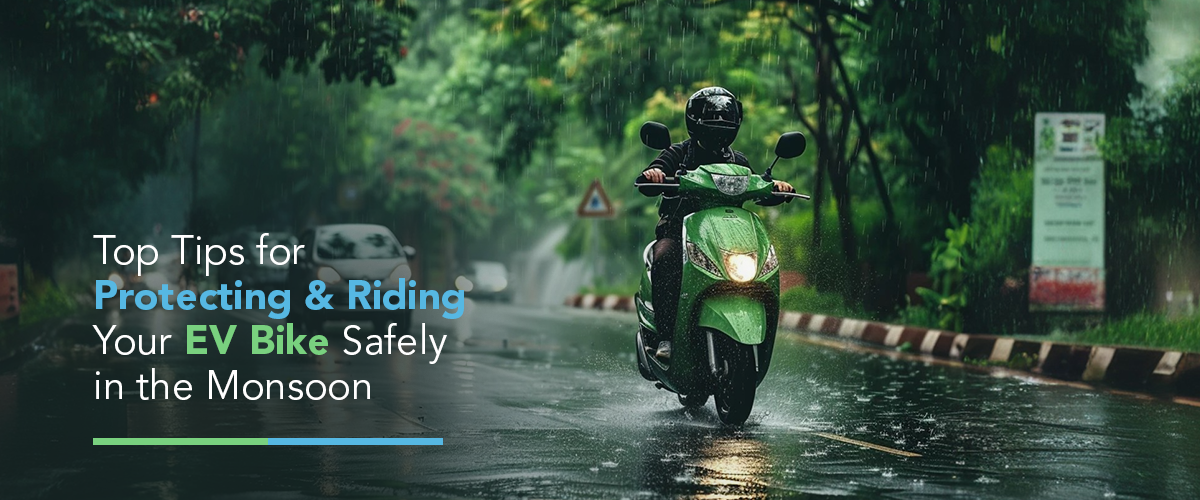The growing popularity of electric bikes in India is undeniable; their convenience, economic value, and environmental friendliness drive up demand. The availability of EV two-wheeler loans has resulted in a significant increase in EV bike and two-wheeler sales.
With such high demand, people use it on a daily basis, for short rides, or when absolutely necessary. It definitely is a good time to enjoy rides in the rain, but be sure to protect yourself and maintain your ride this monsoon season. With the rising demand of EV two-wheelers, here’s a guide that will help you maintain your EV bikes easily and help you ride fearlessly.
Understanding the challenges EV Two-wheelers face during monsoons
Riding during the rainy season is exciting, but it can pose serious risks and long-term consequences for your electric vehicles. The monsoon season affects electric bikes in a different way than traditional bikes.
Here are some problems you can face with your EV two-wheeler:
- Water Ingress: Unlike traditional bikes that run on fuel, electric bikes have a lot of electrical components that can get damaged due to water intrusion.
- Slippery Roads: During monsoons, the chances of skidding or slipping on roads are extremely high, which is why you should check the tyre tread to ensure you get optimal grip.
- Reduced Battery Efficiency: Wet and cold weather can have an impact on battery performance, resulting in shorter battery life and lower efficiency. Also, remove the battery and dry the compartment thoroughly before charging to prevent battery efficiency.
- Corrosion: EV bikes, like traditional bikes, are prone to corrosion. However, corrosion issues must be addressed quickly to maintain electric conductivity.
- Charging Port Damage: Rainy conditions can damage your EV bike’s battery charging port, causing water blockage and shock damage while charging.
Why is it important to maintain your electric bike during monsoon?
- Electrical Safety: Keep the bike’s electrical system dry and intact to avoid short circuits and potential battery failure.
- Physical Damage: Rain and moisture can corrode metallic parts and damage your two-wheeler, weakening its structure.
- Rider’s Safety: Regular maintenance of your bike also prevents accidents and avoidable mishaps due to regular tyre checks or break issues.
Proper bike precautions and maintenance can help you keep both yourself and your bike safe and ready for rides.
Essential Precautions for Monsoon-Proofing Your EV Bike
- Waterproofing Strategies: Invest in quality waterproof covers for your bike when it’s parked. Use dielectric grease on exposed electrical connectors to prevent water ingress.
- Battery Care: Keep the battery dry, and make sure the housing is secure and intact. Avoid charging the battery in wet conditions, and regularly inspect for signs of water damage.
- Tyre Maintenance: Ensure your tyres have adequate tread depth for better grip on wet roads. Regularly check tyre pressure, as it can fluctuate with temperature changes.
Safe Riding Practices in the Rain
The monsoon season is the most exciting time for all riders, but it is also the most dangerous, so riding safely is essential.
Follow these steps to practice safe riding:
- Braking Techniques: Wet roads increase stopping distances. Use both brakes gently and avoid sudden braking to prevent skidding.
- Visibility and Lights: Ensure all lights, including headlights, taillights, and indicators, are functioning correctly. Wear reflective clothing and use a high-visibility jacket for better visibility.
- Riding Speed and Route Planning: Reduce your speed and avoid sudden maneuvers. Plan your routes to avoid flooded areas and stick to roads you are familiar with.
Post-Ride Maintenance Routine
Post-ride maintenance is just as important as regular maintenance because it allows you to check the bike for damage and continue riding.
- Drying and Cleaning: After a ride in the rain, dry your bike thoroughly. Wipe down all surfaces, especially electrical components, to prevent rust and water damage.
- Inspection Checklist: Check for any signs of water ingress, loose components, and tyre conditions. Ensure that the battery and other electrical systems are functioning correctly.
Insurance and Safety Considerations
Having comprehensive insurance is essential for your electric bike. It can protect against water infiltration and other monsoon-related damage. In addition, check with your vehicle loan provider about financing options or insurance packages designed specifically for electric bikes.
Conclusion
Maintaining safety and protecting your EV bike during the monsoon season is crucial. Regardless of the weather, following these tips will ensure a safe and enjoyable riding experience.
If you are planning to buy one of the top electric bikes in India, let us help you ease the financing problems with our EV bike loans. Explore financing options or insurance packages tailored for EV bikes through Manba Finance to add an extra layer of security and peace of mind.
Stay safe, and ride smart!



